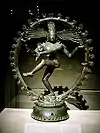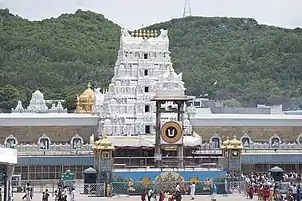Pancharama Kshetras
The Pancharama Kshetras (Sanskrit: पञ्चआरामक्षेत्र, romanized: Pañcārāmakṣetra) or the Pancharamas are five ancient Hindu temples dedicated to the deity Shiva in Andhra Pradesh. According to regional legend, the lingams at these temples (called aramas) are made from a single lingam.[1]
| Part of a series on |
| Shaivism |
|---|
 |
|
|
.svg.png.webp)
Legend
As per regional tradition, a lingam was owned by the asura king Tarakasura. Due to his possession of the lingam, he was invincible in battle. In the war between the devas and the asuras under Tarakasura, Kartikeya and Tarakasura met in combat. Kartikeya used his weapon of shakti to kíll Tarakasura. By the power of this weapon, the body of Tarakasura was torn to pieces. But to the astonishment of Kartikeya, all the pieces reunited to give rise to a revived Tarakasura. He repeatedly broke the asura's body into pieces, and yet the pieces re-unified repeatedly.[2]
Even as Kartikeya grew baffled, Vishnu appeared before him and informed him that Tarakasura would be resurrected as long as the lingam he wore on his form was intact, and hence the lingam would have to be shattered for his victory. The deity also stated that after breaking, the pieces of the lingam would try to reunite. To prevent the lingam from reuniting, all the pieces would have to be established in the places where they would fall, by way of worshipping them and building temples over them.[3]
Heeding the words of Vishnu, Kartikeya used his agneyastra (a celestial weapon of fire) to break the lingam that was worn by Tarakasura. The lingam broke into five pieces, and started to reintegrate to the chant of the sacred syllable Om. Surya, by the order of Vishnu, established the pieces where they fell and worshipped them by building temples over them. After the consecration of the temples, the pieces stopped their attempts to reunite and became famous as the Pancharama Kshetras.[4] All the five lingams in these five places have scale-like marks on them, which are believed to have formed by the power of the agneyastra used by Kartikeya.
Temples
These places (or Aramas) are as follows:[5]
- Amararama (in Amaravathi): Amaravathi is in the Palnadu district, on the banks of the Krishna river. The deity Amara Lingeswara is believed to have been worshipped by Indra here. The temple is old and in three circles with many temples within the compound. Bala Chamundeswari is the goddess venerated here. The Venu Gopala Swami temple is also located in the campus of the main temple.
- Draksharama (in Draksharamam): This is near Ramachandrapuram. The temple is very big and has three circles as compounds. It is under the control of the Archeological department. Rama is regarded to have worshipped Shiva here, followed by Surya and Indra. Manikyamaba devi, one of 18 Shakti Pithas, is present here.
- Somarama (in Bhimavaram): The Someswara Swami temple is in Gunupudi. The temple has a holy pond called the Chandra kundam in front of the temple. Chandra is believed to have absolved himself of his sins here by worshipping Shiva here. Hence, the name of the deity here is called Someswara. The lingam is believed to change its colour according to the lunar month (black at the time of amavasya, white at the time of purnima). The Annapurna Mata temple is located on the second floor.
- Ksheerarama (in Palakollu): According to local legend, the deity Ksheera Rama Lingeswara offered the Sudarshana Chakra to Vishnu here. The sage received boons and milk from Shiva, hence the name kshira (milk). Parvati is the name of the goddess here.
- Kumararama (in Samalkota): The Kumara Bhimeswara Swami temple is in Samalkota. It is about 20 km from Kakinada. It is a very old temple under the control of the Archeological department. Kartikeya is regarded to have established the lingam here, hence the name Kumararama. Bala Tripura Sundari is the goddess worshipped here.
| Arama name | Shiva's name | Consort name | Installor's name | Location | District | State | |
|---|---|---|---|---|---|---|---|
| Amararama | 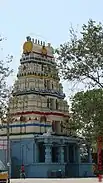 | Amaralingēśvara Śwāmivāru | Bālā Chāmuṇḍikā Ammavāru | Indra | Amaravati | Palnadu district | Andhra Pradesh |
| Draksharama | 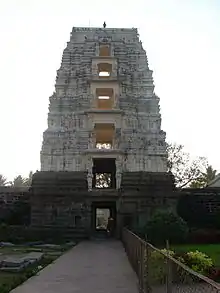 | Bhīmēśvara Śwāmivāru | Māṇikyāmba Ammavāru | Surya | Draksharama | Konaseema district | Andhra Pradesh |
| Somarama | 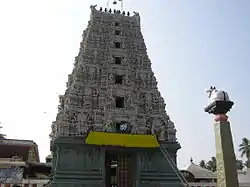 | Sōmēśvara Śwāmivāru | Śrī Rājarājēśvari Ammavāru | Chandra | Bhimavaram | West Godavari district | Andhra Pradesh |
| Ksheerarama | 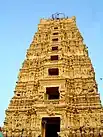 | Kṣīra Rāmalingēśvara Śwāmivāru | Pārvati Ammavāru | Vishnu | Palakollu | West Godavari district | Andhra Pradesh |
| Kumararama |  | Kumāra Bhīmēśvara Śwāmivāru | Bālā Tripura Sundari Ammavāru | Kartikeya | Samalkota | Kakinada district | Andhra Pradesh |
See also
References
- Suriya (26 August 2015). Jothirlingam: The Indian Temple Guide. Partridge Publishing. ISBN 978-1-4828-4786-4.
- Devi, Yashoda (1993). The History of Andhra Country, 1000 A.D.-1500 A.D.: Administration, literature and society. Gyan Publishing House. p. 269. ISBN 978-81-212-0485-9.
- Reddy, K. Thimma (1994). Saivism: Origin, History & Thought : Proceedings of the Seminar on Saivism. Telugu University. pp. 313–315.
- Reddy, K. Thimma (1994). Saivism: Origin, History & Thought : Proceedings of the Seminar on Saivism. Telugu University. p. 316.
- Prasad, B. Rajendra (2009). Early Medieval Andhra Pradesh, AD 624-1000. Tulika Books. ISBN 978-81-89487-54-6.
